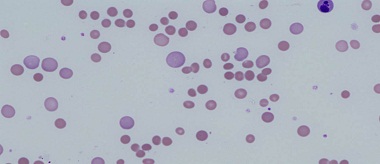A 27-year-old woman is referred for investigation of gradually increasing tiredness. Her appetite is good and she has not lost weight. There is no history of abdominal pain, diarrhoea or constipation. She has two healthy children and has had no recent illnesses. She is not on any medication. There is no history of recent travel.
On examination she is jaundiced. There are no signs of chronic liver disease. Abdominal examination reveals a palpable spleen. The urine is positive for urobilinogen but not bilirubin.
Blood tests show:
Hb 65 g/L
WBC 13.6 × 109/L
Platelets 240 × 109/L
Bilirubin 74 mmol/L
Renal function – normal
Blood film – as illustrated.

-
(a) What abnormalities are shown in the blood film?
Show Answer
Correct answer: The blood film shows spherocytes, polychromasia and anisocytosis (variation in size of red cells).
-
(b) What is the differential diagnosis?
Show Answer
Correct answer: The blood film is highly suggestive of autoimmune haemolytic anaemia (AIHA). Hereditary spherocytosis can give rise to a similar picture but the history suggests her illness is of recent onset.
-
c) What further investigations would you do?
Show Answer
Correct answer:
A direct antiglobulin test (DAT) should be done. This looks for the presence of autoantibody and complement components on the surface of red cells and is positive in >95% of patients with AIHA. A blood group and red cell antibody screen should be undertaken after consultation with the staff in the transfusion laboratory. The reticulocyte count should be estimated. An abdominal CT scan should be considered to confirm the splenomegaly and exclude the presence of lymphadenopathy or other features suggestive of an underlying lymphoma.
-
(d) What underlying conditions would you consider?
Show Answer
Correct answer:
AIHA may be idiopathic. It can also occur in the context of a generalized connective tissue disorder, e.g. systemic lupus erythematosus, rheumatoid arthritis. It can be the presenting feature of some haematological malignancies, e.g. Hodgkin lymphoma, acute lymphoblastic leukaemia, non-Hodgkin lymphoma. It can also occur as a complication of infection, e.g. infectious mononucleosis, viral hepatitis, malaria.
-
(e) How would you treat this patient?
Show Answer
Correct answer:
Tests should be undertaken to exclude underlying conditions. She could then be treated with oral prednisolone and oral folic acid supplements. The dose of steroids should be gradually reduced and then stopped. Additional treatments for AIHA include other immunosuppressive treatment and splenectomy; these are discussed in Chapter 15.

